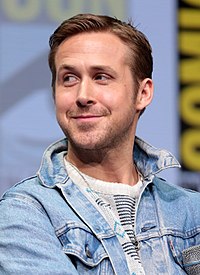First Man: The Life of Neil A. Armstrong
LC Class | TL789.85.A75 H36 2005 | |
First Man: The Life of Neil A. Armstrong is the authorised biography of Neil Armstrong, the astronaut who became the first human to walk on the Moon, on July 20, 1969. The book was written by James R. Hansen and was first published in 2005 by Simon & Schuster. The book describes Armstrong's involvement in the United States space program (culminating in the historic Apollo 11 mission), and details his personal life and upbringing.[1][2]
The book has received a warm reception from several individuals associated with
The book was adapted into the 2018 film First Man.
Development
Academic and author James Hansen is also known for serving as a professor of history at
Armstrong felt impressed with the style of Hansen's work. In June 2002, Armstrong and Hansen signed a formal agreement. Two months later, Armstrong signed an official letter for Hansen that said Hansen had his full support and encouraged others to provide what he needed to write a book. While numerous publications had described aspects of Armstrong's long career and personal endeavors, to varying degrees, First Man became the first official book to detail the astronaut's life, including much information both before and after the Apollo program.[citation needed]
After questioning as to why, after years of reluctance, he had finally consented to a full biography, Armstrong replied simply: "It was time."[2]
Contents and details

The book describes Armstrong's early life as pleasant and broadly conventional. As a young man, he became increasingly fascinated by aircraft and flying, and earned his pilot's licence before learning to drive an automobile. Armstrong's father is quoted as saying his son "never had a girl" and "didn't need a car" but simply "had... to get out to that airport."[1][2]
The young Armstrong became a naval aviator. Management of the
The historic nature of the event meant that Armstrong had to adapt to being one of the most famous men on the planet, a peculiar situation which he found challenging. Given the gravity of the Apollo program and the sacrifices made for the lunar mission to succeed, Armstrong felt determined to make sure that his status as the "first man on the Moon" was never exploited for anyone's petty gain. Interested in spreading his knowledge to younger generations, he eschewed a celebrity status by serving as a lecturer in engineering at the University of Cincinnati. While shying away from the personal spotlight, as an individual, he spent decades advancing the cause of further spaceflight by providing advice to those at NASA, keeping in close touch with multiple figures.[1][2]
Reception
English
American journalist Walter Cronkite lauded First Man as well, remarking:
Even if you think you know everything about Neil Armstrong and America's historic mission to be the first to land men on the Moon, this remarkable book by Dr. James Hansen contributes a host of fascinating new insights into not only the character of Apollo 11's enigmatic commander but also into the nature of the spacefaring enterprise itself. It is a book for all time.[1]
Film adaptation

In early 2003, actor-director Clint Eastwood and production people at the studio Warner Bros. bought the film rights to First Man. Eastwood had previously directed as well as starred in the 2000 space-themed movie Space Cowboys, though he stated that he would likely not appear on camera in First Man.[3] However, the project wound up in development hell despite significant interest. Armstrong himself died on August 25, 2012, before any actual filming took place.
Versions
The first edition was published in hardcover format at a total length of 784 pages in October 2005, later followed by a paperback edition that was 770 pages in length. An abridged audio recording of the book, as read by
A few weeks prior to the release of the film 13 years later, an abridged version of the book was issued in trade paperback format. The abridged edition was 464 pages in length, and had five less chapters than the previous releases, consolidating several chapters covering the front end of Armstrong's life and slightly reorganizing the grouping of the chapters.[7] An extended audio recording of the book, as read by Jeremy Bobb, was released to coincide with the movie's release, this version having a running time of sixteen-and-a-half hours.
See also
- Carrying the Fire: An Astronaut's Journeys, the autobiography of the Gemini 10 and Apollo 11 astronaut Michael Collins
- First on the Moon (Armstrong, Collins, and Aldrin book)
- A Man on the Moon The Voyages of the Apollo Astronauts, a 1994 book
- One Giant Leap, a 2019 book
References
- ^ a b c d e f g h "James R. Hansen". Auburn University - Auburn.edu. Retrieved February 18, 2017.
- ^ a b c d e f g "A giant leap that left few traces". Times Higher Education (THE). January 20, 2006.
- ^ "Eastwood to direct astronaut film biography". Los Angeles Times. March 14, 2003. Retrieved February 19, 2017.
- ^ "Ryan Gosling's Neil Armstrong Biopic Is Set For Fall 2018 Debut". Yahoo. March 7, 2017.
- ^ Fleming, Mike Jr. (November 24, 2015). "Ryan Gosling Orbiting Damien Chazelle's Neil Armstrong Movie at Universal?". Deadline Hollywood. Retrieved December 29, 2016.
- ^ Kroll, Justin (December 29, 2016). "Ryan Gosling, Damien Chazelle to Reteam on Neil Armstrong Biopic". Variety. Retrieved December 29, 2016.
- ISBN 9781982103163. Retrieved February 26, 2021.
